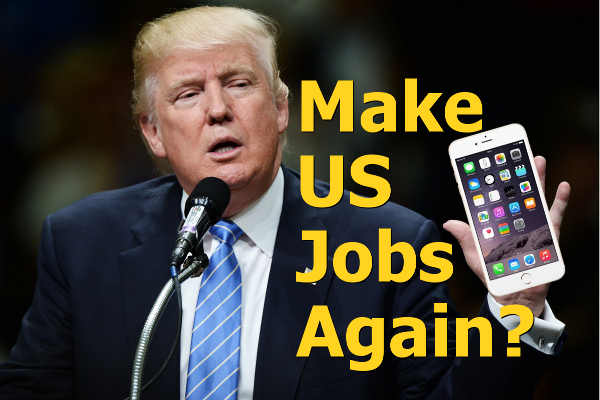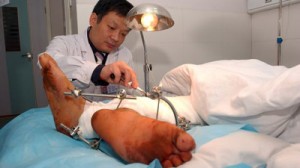Is Apple agreeing when Trump says make iPhones in the USA?

Many analysts laugh when Trump says make iPhones in the USA and expects Apple to move production from China. He isn’t even in office yet & Apple is already talking about it. Is it because of Trump? What does it mean for jobs in the USA?
One discovery of Predictive Innovation is a natural progression of technology from Single, to Multiple, and finally to Continuous types. Continuous are Any, All, & None. Automation is a continuous type, no humans or easy enough for any person to do it. As the costs of robots decrease and communication technology improves, robots become available to more people so the work can happen in more places.
Trump says make iPhones in the USA, China cuts 60,000 Jobs
Foxconn, one of two companies in China that manufacture iPhones for Apple, has cut 60,000 workers from a single factory this year replacing them with 40,000 robots. They have plans to produce 10,000 more robots per year. That means 15,000 fewer employees every year.
Apple looking at moving iPhone production to the USA is following the natural steps towards anyone producing anywhere. It is distributed production. When the costs of this technology drop to make it more profitable, Apple and others will distribute some production away from China closer to consumers. This is a different form of globalization. Anyone, anywhere, producing anything for their local consumers.
Trump’s proposed lower taxes removes a barrier. In that way Trump could help cause Apple and others to start producing in the USA. Is that good for US jobs? Not really. Is it good for US citizens? It’s great for citizens everywhere, eventually.
Foxconn is moving away from human workers to robots. Robots cost less than paying even low wage Chinese labor. That means robots cost far less than US workers. The new production will be heavily automated. It will not create more jobs. It will create some new jobs but overall will reduce jobs. Depending on how we adapt culturally this could be great or it could be terribly painful.
There are two paths
People could choose the fun easy path and life would be great. It doesn’t seem like enough people are heading that direction. My concern is people will continue on the painful path until society finally catches up with technology. Even if there are more jobs when they make iPhones in the USA it won’t solve long term cultural problems from the economic changes.
Historically these big radical cultural changes require 20-50 years. There isn’t any fundamental barrier, it just tends to be that way. There are reasons for the tendency but those could be changed tomorrow if people wanted.
Is software eating the world?
Don’t think this change is caused by automation. The change is a natural progression towards Any, All, & None. Robotics or computerized systems are tools for achieving that result. Those aren’t the only tools. The same result can be achieved in other ways. For instance anything that makes a task possible for anyone to do is an Any type. Making information widely available such as a system of libraries or just a culture of sharing knowledge could do it. If you teach two people a skill then the next day they each teach two more people that skill, all 7 billion people on Earth are trained in just one month. Better yet make the task unneeded, that is a type of None. Incorporating the solution into another part of the larger system is also a way of achieving a type of None.
Schools don’t teach the skills needed for this change. The media & politicians don’t promote the values and mindset needed to adapt to this change. As I said there isn’t anything preventing people from changing tomorrow, they just need to know what to do and be willing to do it.
The way forward
I’ve mapped out ways to deal with the changes. Many are low tech. Most require little investment. All dramatically improve life for everyone. There are things Apple can do, there are things China can do, there are things President Trump can do, most importantly there are things you can personally do. My next book covers the biggest future challenge facing all leaders.
Cheap Natural Gas Transportation Idea
Poor people in China transport natural gas in large plastic bags. If this could be made safe it’s a very low cost alternative to expensive pipelines. Natural gas could be quickly and cheaply distributed to places without infrastructure.
http://www.dailymail.co.uk/news/article-2108346/Chinese-villagers-carry-giant-balloons-stolen-natural-gas-heat-homes.html
Running underground pipes is a large investment. The small amount of natural gas these people would use doesn’t make that investment worth while.
The danger is if the gas is ignited. Three things are required to cause this danger, enough oxygen for ignition, natural gas mixed with oxygen, spark or flame.
A very simple solution is to put the natural gas bag inside another bag filled with carbon-dioxide. This would prevent ignition. CO2 could also be used to prevent an explosion while filling the bag with natural gas. First fill the bag with CO2 then use the natural gas to force out the CO2 into another empty bag of the same size. When the second bag is full you know the first bag is filled with natural gas. The process could then be repeated with the second bag.
Doctors save left foot by attaching it to right leg
Doctors in China use many principles of Predictive Innovation® to save a man’s foot when it was cut off in an accident.
http://web.orange.co.uk/article/quirkies/Doctors_put_left_foot_on_right_leg
The man’s foot was cut off because of an accident. The damage to the leg prevented the foot from being immediately reattached. So there was a dilemma.
Must re-attach the foot to the leg immediately so it doesn’t die; but, we can’t attach the foot until the leg heals and grows.
One way to handle dilemmas is to invert then rephrase. Instead of immediately reattaching the foot to the same leg they attached it to the other leg. This was a great idea because the patient would not be able to walk while the other leg was growing and healing after moving it to the correct leg. Attaching the foot to the patients other leg is the perfect environment for the foot while waiting.
Other approaches have been tried such as freezing the organ to be reattached. Current technology can’t reliably prevent damage from ice crystals.
Another improvement could be using stem cells cultured from the patient and sprayed onto a growth matrix. This could accelerate the grow and the healing when the foot is reattached.
Another inversion is to let the foot die and attach a cloned foot. That technology has already been used for less complicated body parts.




 Predictive Innovation Training
Predictive Innovation Training Predictive Innovation: Core Skills Book
Predictive Innovation: Core Skills Book RoundSquareTriangle.com
RoundSquareTriangle.com